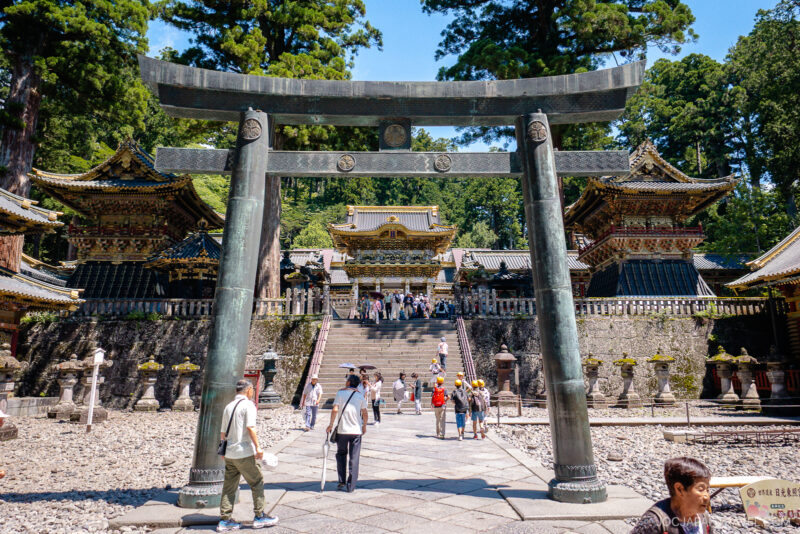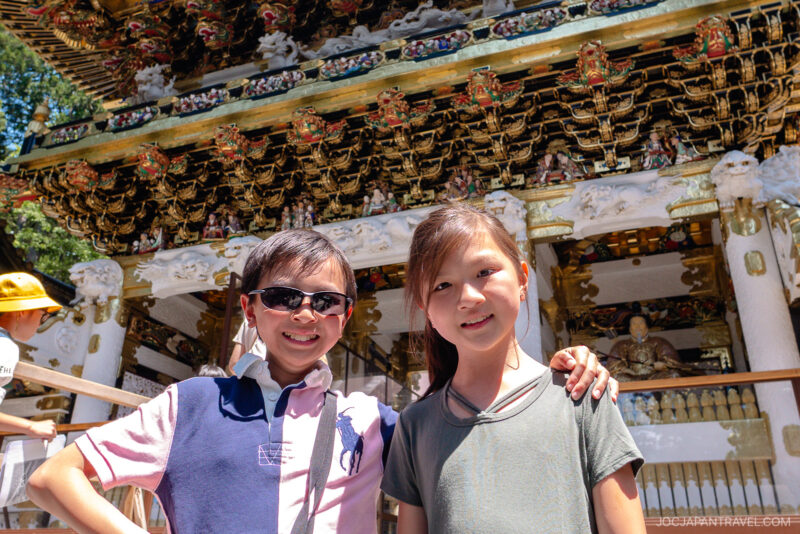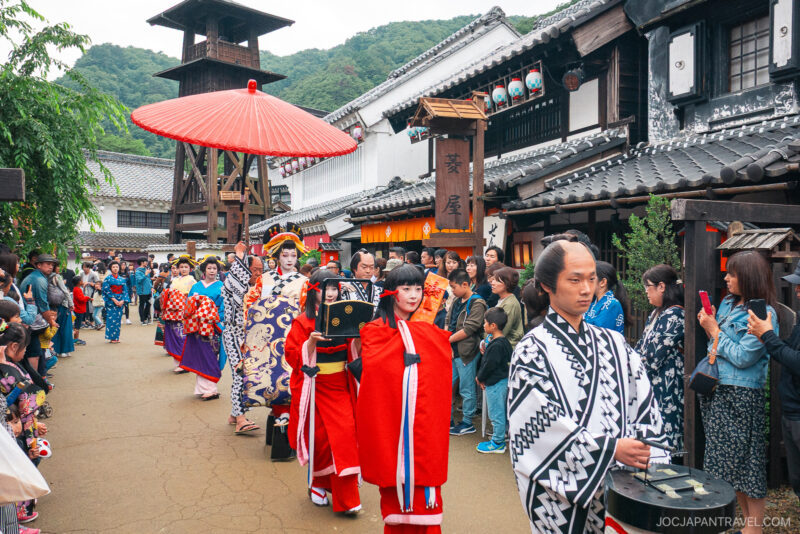This post may contain affiliate links. Please read our disclosure policy.
Step into Nikko Toshogu Shrine, a UNESCO World Heritage Site where golden gates, intricate carvings, and centuries of history honor Tokugawa Ieyasu, the founder of the Tokugawa Shogunate.

Why Nikko Toshogu Shrine Matters
Nikko Toshogu Shrine is one of Japan’s most important cultural landmarks. Built in 1617, it enshrines Tokugawa Ieyasu, the shogun who unified Japan and established the Tokugawa Shogunate. His grandson, Tokugawa Iemitsu, expanded the shrine into the elaborate complex we see today.
The grounds include 55 structures, with eight recognized as National Treasures and many others as Important Cultural Properties. Together with Futarasan Shrine and Rinnoji Temple, it forms part of the UNESCO World Heritage Site “Shrines and Temples of Nikko.”
Extravagant Design and History

Unlike the understated style often seen in Shinto shrines, Toshogu is strikingly ornate. Every surface seems alive with gold leaf, brilliant lacquer, and over 500 detailed carvings. The cost of rebuilding the complex today would exceed 40 million US dollars, a reminder of the wealth and influence of the Tokugawa clan.
Main Highlights of Nikko Toshogu Shrine

Front Gate and Five-Story Pagoda
Visitors first pass through a massive stone torii gate built in 1618 with stone carried from Kyushu. Beyond it stands the vibrant Five-Story Pagoda. Though not open to the public, its bright red exterior and intricate carvings are a striking start to the shrine.
Nio Gate and Sacred Storehouses
The Nio Gate (仁王門), a feature usually seen in Buddhist temples, reflects Japan’s historical blending of religions. Nearby are the Three Sacred Storehouses, decorated with iconic carvings such as the Three Wise Monkeys and the imaginative Elephants carved by artists who had never seen the real animal.
Lanterns Across the Grounds
Over 120 stone and bronze lanterns line the paths. Each was donated by a feudal lord, with allies’ lanterns placed prominently and rivals’ gifts positioned discreetly at the edges.
Yomeimon and Karamon Gates

The most famous feature is Yomeimon Gate, adorned with over 500 carvings of mythical beasts, dragons, and scenes from Tokugawa Ieyasu’s life. A painted dragon in the rafters is easy to miss unless you look up. Just beyond is the smaller but equally ornate Karamon Gate, leading to the Main Shrine.
Inside, portable mikoshi shrines are displayed, used during the shrine’s spring and autumn festivals to honor Ieyasu along with other legendary leaders such as Minamoto no Yoritomo and Toyotomi Hideyoshi.
Nemuri Neko and Ieyasu’s Tomb

Climbing 207 stone steps brings visitors to the Inner Shrine and Tokugawa Ieyasu’s tomb. At the entrance is the small but famous Nemuri Neko (Sleeping Cat), symbolizing peace. Ieyasu’s mausoleum sits quietly among towering cedar trees, simple compared to the grandeur of the main shrine.
Crying Dragon at Yakushido Temple
Just outside the main shrine, Yakushido Temple features the “Crying Dragon” ceiling painting. When clapped beneath its head, the acoustics create a resonant echo that resembles the dragon’s cry—a unique fusion of art and sound.
Nikko Toshogu Museum
The nearby museum houses Tokugawa artifacts, including armor and personal belongings of Ieyasu. If you are short on time, this section can be skipped, as it requires a separate entry ticket.
The Mystery of Ieyasu’s Burial
While Nikko Toshogu is the most prominent shrine dedicated to Tokugawa Ieyasu, some believe his actual remains lie at Kunozan Toshogu in Shizuoka. Since neither shrine has opened the tomb for examination, the question remains unanswered.
How to Get to Nikko Toshogu Shrine
Train
By Tobu Train: From Asakusa (浅草), take the Tobu Limited Express to Tobu-Nikko Station (東武日光駅). The ride takes about two hours. From the station, ride a local bus for about ten minutes or walk about thirty minutes to the shrine.
By JR Train: From Tokyo Station or Ueno Station, ride the Tohoku Shinkansen to Utsunomiya (宇都宮). Transfer to the JR Nikko Line for JR Nikko Station (日光駅). The total trip takes about two hours. From the station, take a local bus for about ten minutes or walk about thirty minutes.
Bus
By Bus in Nikko: From Tobu-Nikko Station or JR Nikko Station, board the World Heritage Sightseeing Bus. Get off at Omotesando or Toshogu stops. Buses run often and the ride is short.
Car
By Car: Driving from central Tokyo takes about two to two and a half hours. Paid parking is available near the shrine area. Follow signs for Toshogu Parking.
Walking Notes: The approach has uphill paths and stone steps. Wear comfortable shoes, especially in wet weather.
Pro Tip: Arrive early on weekdays. If you plan to see more of Nikko, consider a Tobu Nikko travel pass that includes trains and buses.
Is Nikko Toshogu Shrine Worth Visiting?

Nikko Toshogu Shrine is one of Japan’s most spectacular cultural treasures. Its elaborate carvings, golden gates, and historical significance make it a must-see destination. While the climb to Ieyasu’s tomb requires effort, the experience of walking through centuries of artistry and symbolism is unforgettable. Families, history fans, and first-time visitors to Japan will all find something meaningful here.
More to Explore Nearby
Once you’ve explored Nikko Toshogu Shrine, you’ll find other historic and natural highlights nearby:
- Shinkyo Bridge – The iconic red-lacquered bridge at the entrance to Nikko’s shrine area.
- Rinnoji Temple – A major Buddhist temple with large statues of Buddhist deities.
- Futarasan Shrine – Another UNESCO World Heritage Site known for mountain worship.
- Kanmangafuchi Abyss – A scenic riverside trail lined with rows of stone Jizo statues.




